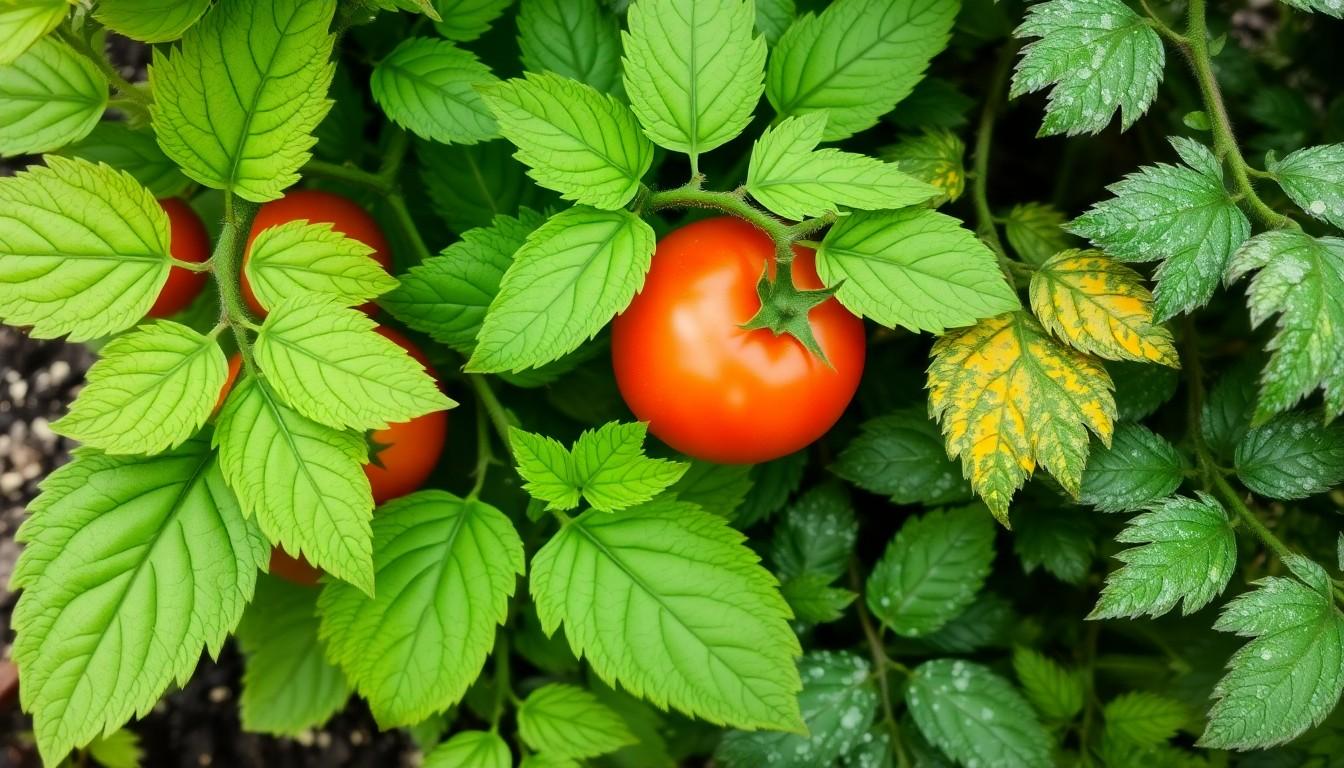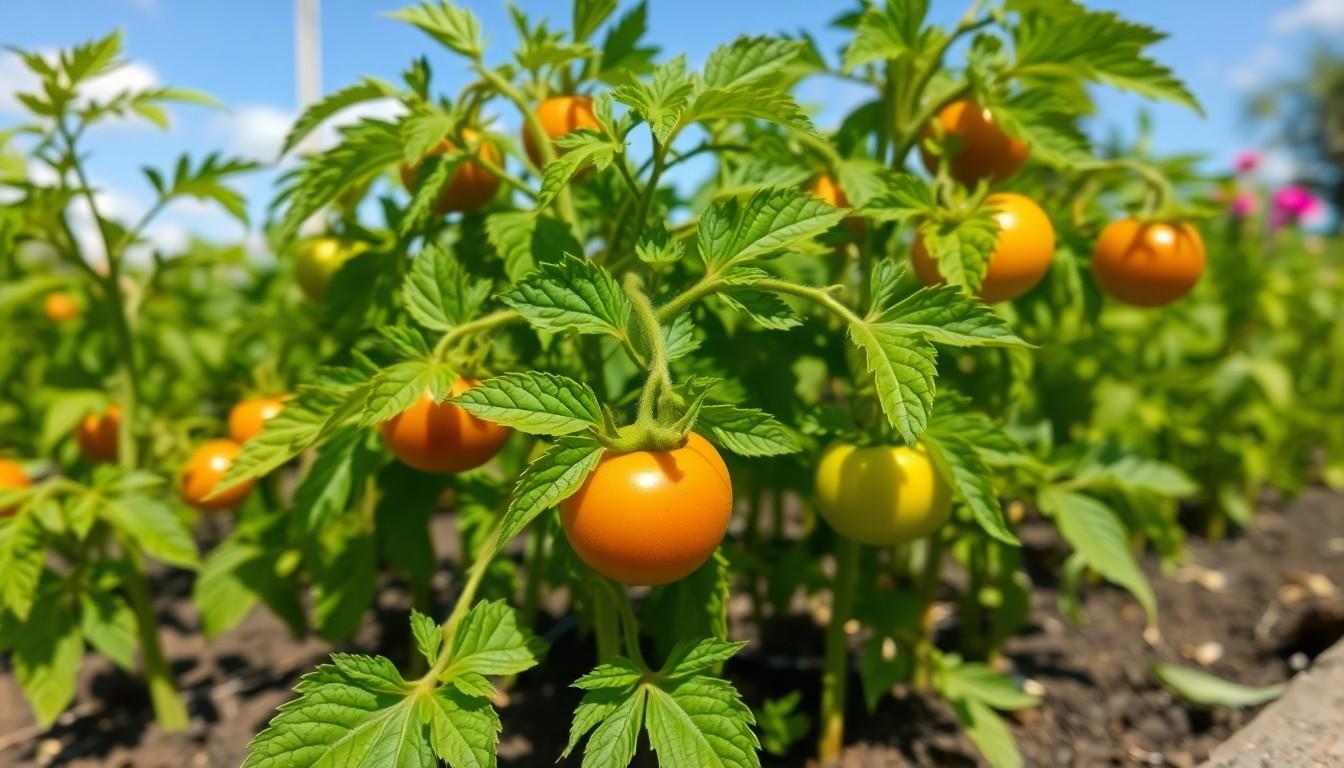Tomatoes are the crown jewels of any garden, but even these vibrant veggies can fall victim to a host of sneaky diseases. Picture this: you’ve nurtured your plants with love, only to find them wilting under the weight of blight or blossom end rot. It’s a gardener’s nightmare! But fear not, for knowledge is the best fertilizer.
Overview Of Common Tomato Plant Diseases
Tomato plants face various diseases that can hinder their growth and fruit production. Blight ranks among the most notorious, manifesting as dark spots on leaves. This fungal disease thrives in humid conditions, making prevention critical.
Another common issue is blossom end rot, a physiological disorder often linked to irregular watering. Symptoms include dark, sunken spots on the blossom end of fruit. Regular watering practices can help minimize its occurrence.
Fusarium wilt presents another challenge, caused by soil-borne fungi. Infected plants exhibit yellowing leaves, wilting, and stunted growth. Ensuring proper soil drainage and crop rotation can reduce the risk of this disease.
Septoria leaf spot occurs when small, circular spots develop on leaves, leading to early leaf drop. This fungal disease spreads rapidly in wet conditions. Implementing good sanitation practices and spacing plants adequately can help mitigate its impact.
Early blight typically targets older leaves, resulting in dark lesions. The disease can advance quickly, weakening the entire plant. Use of resistant varieties and applying fungicides can manage its onset effectively.
Root rot, associated with overwatering, affects the root system. Plants may display wilting despite adequate soil moisture. Allowing the soil to dry between watering sessions is crucial for prevention.
Understanding these diseases empowers gardeners to take preventative measures. Identifying symptoms early enables timely intervention, which reduces loss and promotes healthy tomato yields.
Fungal Diseases

Fungal diseases pose significant challenges for tomato plants. Understanding the symptoms and prevention strategies for these issues can enhance gardening success.
Early Blight
Early blight primarily affects older leaves, showing dark, concentric rings around brown spots. It thrives in warm, humid environments, especially during the growing season. Notably, good air circulation reduces the risk. Implementing crop rotation can also help to prevent its recurrence in subsequent years. The application of fungicides may provide effective control if symptoms emerge.
Late Blight
Late blight, caused by the pathogen Phytophthora infestans, leads to rapid deterioration of both leaves and fruit. Typically, it appears as water-soaked lesions on foliage, which quickly turn dark and mushy. Favorable conditions include cool, moist weather with high humidity. Quick action is crucial; removing affected plants helps limit spread. Fungicides can also minimize damage when used preventively or at the first sign of symptoms.
Powdery Mildew
Powdery mildew manifests as a white, powdery coating on leaves and stems. This disease thrives in dry, warm conditions, making overcrowded plants particularly vulnerable. Enhanced air circulation through proper spacing can significantly reduce its onset. Regularly pruning foliage and applying fungicides helps alleviate the problem. Timely management ensures tomato plants remain healthy and productive.
Bacterial Diseases
Bacterial diseases pose significant threats to tomato plants. Gardeners must recognize and address these issues promptly.
Bacterial Spot
Bacterial spot manifests through small, dark lesions on leaves and stems. The lesions might have yellow halos, making them more noticeable. This disease spreads easily in wet conditions, especially during humid weather. Managing this condition requires good air circulation around plants. Infected plants decrease tomato yield and quality, leading to losses. To prevent bacterial spot, use resistant varieties and practice proper hygiene in the garden.
Bacterial Wilt
Bacterial wilt causes rapid wilting of leaves, often starting with lower leaves. Affected plants may show yellowing before drooping occurs. This difficult disease results from soil-borne bacteria, which can survive in the soil for years. Infected tomatoes often succumb quickly, leaving little time for treatment. Avoid planting in infested areas and rotate crops regularly. Remaining vigilant helps minimize the impact of bacterial wilt.
Viral Diseases
Viral diseases significantly impact tomato plant health, causing various symptoms that can lead to reduced yields. Identifying these issues promptly is crucial for effective management.
Tobacco Mosaic Virus
Tobacco Mosaic Virus, known for its distinctive mottled leaf appearance, can seriously hinder tomato production. Affected plants typically show stunted growth and distorted leaves. This virus spreads through mechanical means, often via contaminated tools or hands. Gardeners must emphasize sanitation practices and avoid planting in areas previously infected. Resistant tomato varieties can minimize risk, making them a wise choice for long-term success.
Tomato Yellow Leaf Curl Virus
Tomato Yellow Leaf Curl Virus causes yellowing and curling of leaves, leading to poor fruit development. Infected plants often exhibit reduced vigor and ultimately lower yields. The primary vectors of this virus are whiteflies, which can quickly spread the disease. Implementing preventative measures, such as using insect nets and introducing beneficial insects, helps control whitefly populations. Selecting resistant cultivars also plays a crucial role in battling this viral threat.
Preventing And Managing Diseases
Preventing tomato plant diseases involves proactive measures focused on plant health. Proper spacing allows for adequate air circulation, reducing humidity that fosters disease. Regularly inspecting plants can help identify early signs of trouble. Crop rotation minimizes disease buildup in soil by changing the planting location yearly. Choosing resistant tomato varieties enhances the chances of success against common diseases. Additionally, consistent watering practices prevent issues like blossom end rot by avoiding fluctuations.
Best Practices For Healthy Tomato Plants
Establishing a routine for plant care significantly impacts tomato health. Mulching retains soil moisture while suppressing weeds. Providing support for plants encourages good airflow around leaves. Maintaining soil health through compost or organic fertilizers builds robust plants. Regular pruning removes diseased or dead foliage, improving air circulation. Keeping the garden area clean prevents pest and disease spread. Diversifying plant species in the garden can also deter disease proliferation.
Chemical And Organic Treatments
Using targeted chemical treatments can effectively manage tomato diseases. Fungicides combat fungal infections when applied according to instructions. Bacterial diseases respond to copper-based sprays, limiting their spread. Organic options, such as neem oil or diatomaceous earth, offer safer alternatives for disease control. Introducing beneficial insects supports natural pest management. Applying compost teas can improve soil health, enhancing plant resilience. Monitoring weather conditions also aids in timing treatments for optimal effectiveness.
Conclusion
Gardening enthusiasts can significantly improve their tomato yields by being aware of common diseases that affect these plants. Recognizing symptoms early allows for timely intervention which can make all the difference.
Implementing preventative measures such as crop rotation and selecting resistant varieties can help mitigate risks. Additionally maintaining proper watering practices and ensuring good air circulation are crucial steps in promoting plant health.
By staying informed and proactive, gardeners can cultivate thriving tomato plants while minimizing the impact of diseases. With the right knowledge and strategies, a bountiful harvest is well within reach.

